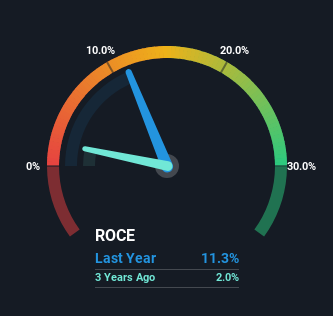Stock Analysis
- India
- /
- Hospitality
- /
- NSEI:DEVYANI
The Return Trends At Devyani International (NSE:DEVYANI) Look Promising

What trends should we look for it we want to identify stocks that can multiply in value over the long term? Firstly, we'd want to identify a growing return on capital employed (ROCE) and then alongside that, an ever-increasing base of capital employed. Ultimately, this demonstrates that it's a business that is reinvesting profits at increasing rates of return. With that in mind, we've noticed some promising trends at Devyani International (NSE:DEVYANI) so let's look a bit deeper.
Return On Capital Employed (ROCE): What Is It?
Just to clarify if you're unsure, ROCE is a metric for evaluating how much pre-tax income (in percentage terms) a company earns on the capital invested in its business. The formula for this calculation on Devyani International is:
Return on Capital Employed = Earnings Before Interest and Tax (EBIT) ÷ (Total Assets - Current Liabilities)
0.11 = ₹2.9b ÷ (₹31b - ₹5.9b) (Based on the trailing twelve months to December 2023).
So, Devyani International has an ROCE of 11%. That's a pretty standard return and it's in line with the industry average of 11%.
See our latest analysis for Devyani International

In the above chart we have measured Devyani International's prior ROCE against its prior performance, but the future is arguably more important. If you'd like to see what analysts are forecasting going forward, you should check out our free analyst report for Devyani International .
What Does the ROCE Trend For Devyani International Tell Us?
Devyani International is displaying some positive trends. The numbers show that in the last five years, the returns generated on capital employed have grown considerably to 11%. Basically the business is earning more per dollar of capital invested and in addition to that, 184% more capital is being employed now too. This can indicate that there's plenty of opportunities to invest capital internally and at ever higher rates, a combination that's common among multi-baggers.
On a related note, the company's ratio of current liabilities to total assets has decreased to 19%, which basically reduces it's funding from the likes of short-term creditors or suppliers. So shareholders would be pleased that the growth in returns has mostly come from underlying business performance.
Our Take On Devyani International's ROCE
A company that is growing its returns on capital and can consistently reinvest in itself is a highly sought after trait, and that's what Devyani International has. Investors may not be impressed by the favorable underlying trends yet because over the last year the stock has only returned 5.9% to shareholders. Given that, we'd look further into this stock in case it has more traits that could make it multiply in the long term.
Devyani International does come with some risks though, we found 3 warning signs in our investment analysis, and 1 of those is concerning...
While Devyani International isn't earning the highest return, check out this free list of companies that are earning high returns on equity with solid balance sheets.
Valuation is complex, but we're helping make it simple.
Find out whether Devyani International is potentially over or undervalued by checking out our comprehensive analysis, which includes fair value estimates, risks and warnings, dividends, insider transactions and financial health.
View the Free AnalysisHave feedback on this article? Concerned about the content? Get in touch with us directly. Alternatively, email editorial-team (at) simplywallst.com.
This article by Simply Wall St is general in nature. We provide commentary based on historical data and analyst forecasts only using an unbiased methodology and our articles are not intended to be financial advice. It does not constitute a recommendation to buy or sell any stock, and does not take account of your objectives, or your financial situation. We aim to bring you long-term focused analysis driven by fundamental data. Note that our analysis may not factor in the latest price-sensitive company announcements or qualitative material. Simply Wall St has no position in any stocks mentioned.
About NSEI:DEVYANI
Devyani International
Devyani International Limited develops, manages, and operates franchised quick service restaurants and food courts in India, Nepal, and Nigeria.
High growth potential with imperfect balance sheet.

